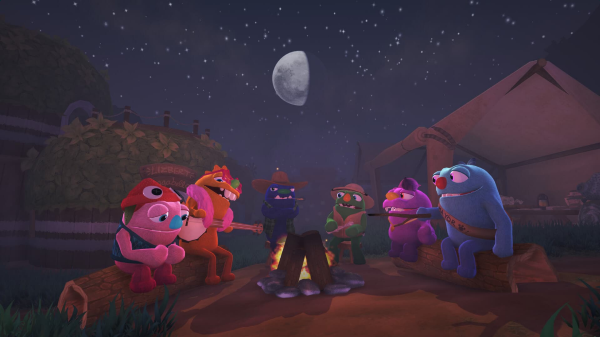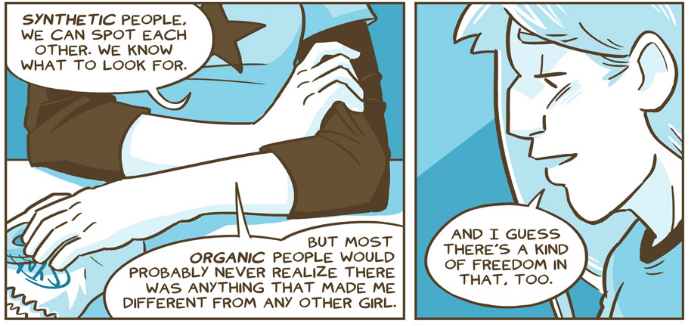cn: no spoilers in the OP, but spoilers permitted in comments
Over break, I tried playing Bugsnax, a video game about catching snack-themed bug monsters. I expected a light and colorful game, but I got something more story-oriented, and way more queer. And that’s not just me reading into it–basically anyone who plays through the game will know that there are not one but two same-sex couples in its cast of 13. Fewer players realize this, but there is also a nonbinary character.

Source: Young Horses
My attitude towards queerness in video games is as a nice-to-have. I don’t really expect it, and I expect little out of it. Bugsnax having many queer characters is a pleasant surprise. But I read webcomics whose casts are 100% queer, so for me the novelty is only in the medium, and not in the queerness itself.
What really pleased me about Bugsnax is that it is an excellent example of what I’m calling twofold queer representation. It has queer characters… and queer-coded themes. The queer themes are never explicitly labeled as queer, and have no direct connection to the queerness of the characters. Nonetheless, the significant presence of queer characters cues the player to look for queer interpretations of the rest of the story–and find them.
The family we chose along the way
The titular bugsnax appear on the remote island of Snaktooth. Thus, each of the main characters is someone who has decided to leave civilization. Often it’s because they were failures or pariahs. At least one mentions family troubles. None of them says it’s because they were queer. Nonetheless, this is a queer-resonant theme, because many queer people find themselves having to leave their old lives behind–perhaps leaving a family that didn’t accept them, leaving old friends, or just moving to a new location to start a new life free of old expectations.
Many of the characters believe that bugsnax are the solution to their problems. However, the observant player will see that the real treasure on Snaktooth is not bugsnax, but the family they made along the way. When the player arrives on Snaktooth, the village has recently had a fight, and the entire cast has scattered to pursue bugsnax-related solutions on their own. The main goal of the game is to persuade the characters to reunite, to help them realize that they need each other more than they need bugsnax.

Source: Young Horses
The name of the trope is found family, or chosen family. As I’ve previously discussed, the term “chosen family” originated in LGBTQ communities, and it continues to have very strong LGBTQ associations. People who are LGBTQ often face rejection from their families of origin, and the solution is to make new families with each other. I’m not saying that chosen families are exclusive to LGBTQ people, nor am I saying that chosen families resonate with the all LGBTQ audiences. However, when there are a bunch of characters who have been rejected by society, and who form a new family with each other, this is a very strongly queer-coded narrative.
A queer-coded narrative is not the same as a narrative that is queer in-universe. Within the universe of Bugsnax, queerness appears to be totally accepted, and even unworthy of comment. So for instance, when one of the characters hints at abuse or neglect from their family, I would argue that it is unlikely that this character was abused because they were queer, because that would be inconsistent with the world-building of Bugsnax. Queer-coding merely means is that we as players may recognize it as analogous and resonant with queerness in our own world.
Twofold queerness as a trope
Even if you accept that the chosen family theme of Bugsnax is queer, and accept that there are queer characters, you might not see any connection between the two. Why describe the juxtaposition of queer characters and queer themes as a trope, rather than merely a juxtaposition of two separate tropes?
I describe it as a trope, because I see it all the time in queer webcomics. For instance, a webcomic might be about two women with a forbidden love for each other—but it’s not forbidden because they’re queer, but because they’re nuns with a vow of chastity. Or, everybody in this queer ensemble is oppressed by society, but not because they’re queer, but because they have magical powers. In one of my favorite examples, a character expresses anxiety about “passing”—but not because she’s trans (although she is), but because she’s a robot.

A particularly blatant example of twofold queerness. Source: O Human Star
I would go so far as to say this is practically the default structure of queer webcomics. Have a queer ensemble cast, give ’em superpowers, which many of them keep hidden because people with superpowers are an oppressed class. And although this trope does not by itself make a good story, I think it’s a really solid trope, and popular in this space for a reason. I would not be surprised if it were also popular in other media such as YA or fanfic.
The thing about queer representation, is that people want all sorts of different things. Some folks just want to see queer characters who are comfortable with their queerness, so that they too can learn to be comfortable. Some folks want representation that is instructive in some way, because they like imagining that other members of the audience have learned to better accept queer people. Some folks want fiction that addresses the problems that they face in life, as queer people. (Also see: my essay on different things people want in ace literature.)
These desires conflict with one another. Do we show queer characters living an escapist fantasy? Or do we show them struggling? Why not both? We can have queer characters living an escapist fantasy, while also showing them struggle with problems that echo those faced by queer people.
The optionality of queer interpretation
In Gayming Magazine, Stacey Henley praises Bugsnax for its “queer paradise”, in contrast to other games, where queer narratives are “often pushed off to the side or mired in tragedy.” For example,
In The Last Of Us Part II, transgender character Lev is occasionally deadnamed and his entire story revolves around the hurt and suffering being transgender causes, while leading queer couple Ellie and Dina are called slurs even in their own settlement, and in a world where everyone remembers Jurassic Park and Pearl Jam, nobody knows what the Pride flag means.
I can see that in this context a player may get exhausted with queer tragedies, and see Bugsnax as a welcome relief. However, I am personally not in the same place, having consumed a different diet of queer media with an emphasis on asexual and gay representation in webcomics, books, and movies. While I don’t exactly look forward to queer tragedies, neither am I exhausted by them. What I have been exhausted by, are stories where characters are queer, but it doesn’t impact the story in any meaningful way. To me, this feels like the stories don’t have anything to say about queerness, and instead the queer characters are there for the benefit of straight people who are still getting used to our presence.
(To be fair, queer people also need to get used to their own presence. So this is not to downplay the value of such stories, but to express the lack of value in me personally consuming them.)
I enjoyed the story of Bugsnax, because I felt it had something to say about queerness and chosen families, beyond the mere fact that they are present. I like how it presents the family as drawn together by a mutual obsession with bugsnax, and how this obsession ultimately gets in their way. I like the intricate web of relationships between characters of vastly different viewpoints, such as the character who wants treats bugsnax as pets, and the character who treats them as livestock.
Stacey Henley seems to have gotten something very different out of Bugsnax, and her article does not even mention the queer chosen family theme. Instead she reads Bugsnax as a depiction of wholesome village life, and this reading has merit. And that’s the great thing about twofold queerness: the queer interpretation is totally optional. Chosen families are a theme that is not immediately obvious to many queer people, and which does not resonate with all queer people. So if the queer interpretation does not resonate with you, then you can take another interpretation as you please.
The problem with optional queer interpretations is that people might miss an interpretation they would otherwise benefit from. It can lead to arguments with straight people about whether the queerness is really there. And it may leave us concerned about the intentions of the author, who might have only included queer themes on accident. But having explicit queer characters addresses many of these problems. Understanding the ins and outs of queer experiences may be optional, but recognizing our presence is not.
Twofold queerness is a trope that cleverly satisfies a broad range of needs in queer representation. I am very pleased to see it appear in Bugsnax and look forward to seeing it more often in all kinds of media.

… you magnificent bastard, you just made me binge all of ‘O Human Star’ in one sitting and it was beautiful.
My favorite stories with LGBTQ+ characters are ones in which their sexual orientation or gender identity is treated as totally normal and ordinary in-universe. There is no great reveal. For example, a character says, “I am busy today evening, I have a date with my boyfriend,” while making plans for work, and from this the reader finds out that this character is gay. There is no big reveal, they aren’t outed, instead their sexual orientation is treated as totally ordinary and no big deal in-universe.
Alternatively, I remember a story with a lesbian couple as protagonists in which nobody even paid attention to the fact that both were women. Then at some point readers and protagonists are introduced to a young woman, a new character, and the protagonist asked her, “Wasn’t there a son in your family, you must be his sister?” to which the girl replied, “Oh, that was me.” This new character was introduced to readers as a trans woman immediately, but after that introduction nobody paid any attention to the fact that she was trans. The plot included some romance and action and was about a conflict between two kingdoms, but none of the characters ever had any difficulties due to being lesbian or trans.
What appeals to me in these stories is the inclusive world in which LGBTQ+ characters are treated as just regular people. I’d like to live in a world in which LGBTQ+ people can have normal lives and nobody bats an eyelid about their sexual orientation or gender.
I’m in the same camp, but from a slightly different angle. Recently I’ve been reading a lot of inclusive interactive fiction. If there is the option to be trans (or god forbid: Demi. Nobody ever gets demi right.), I usually take it. I always foolishly expect it to actually have some impact on the narrative. It never does. The authors all just hand-wave it away. Nobody ever clocks you. You never get dysphoric or uncomfortable. Nobody’s bigoted, not even the villains. Might as well have chosen to be cis.
Which is absolutely fine if you’re looking for escapism. I totally get it.
But games/stories have such massive potential to (productively) explore these issues. Or to simply enrich their characters. I think most authors shy away from it because they don’t want to do the queer community a disservice by getting something wrong. Personally, I’d prefer they at least try.
And AAA games? Forget about it. The best one can usually hope for is the Disney treatment.
Thanks! I enjoyed this, and will check out Bugsnax because of your reading.